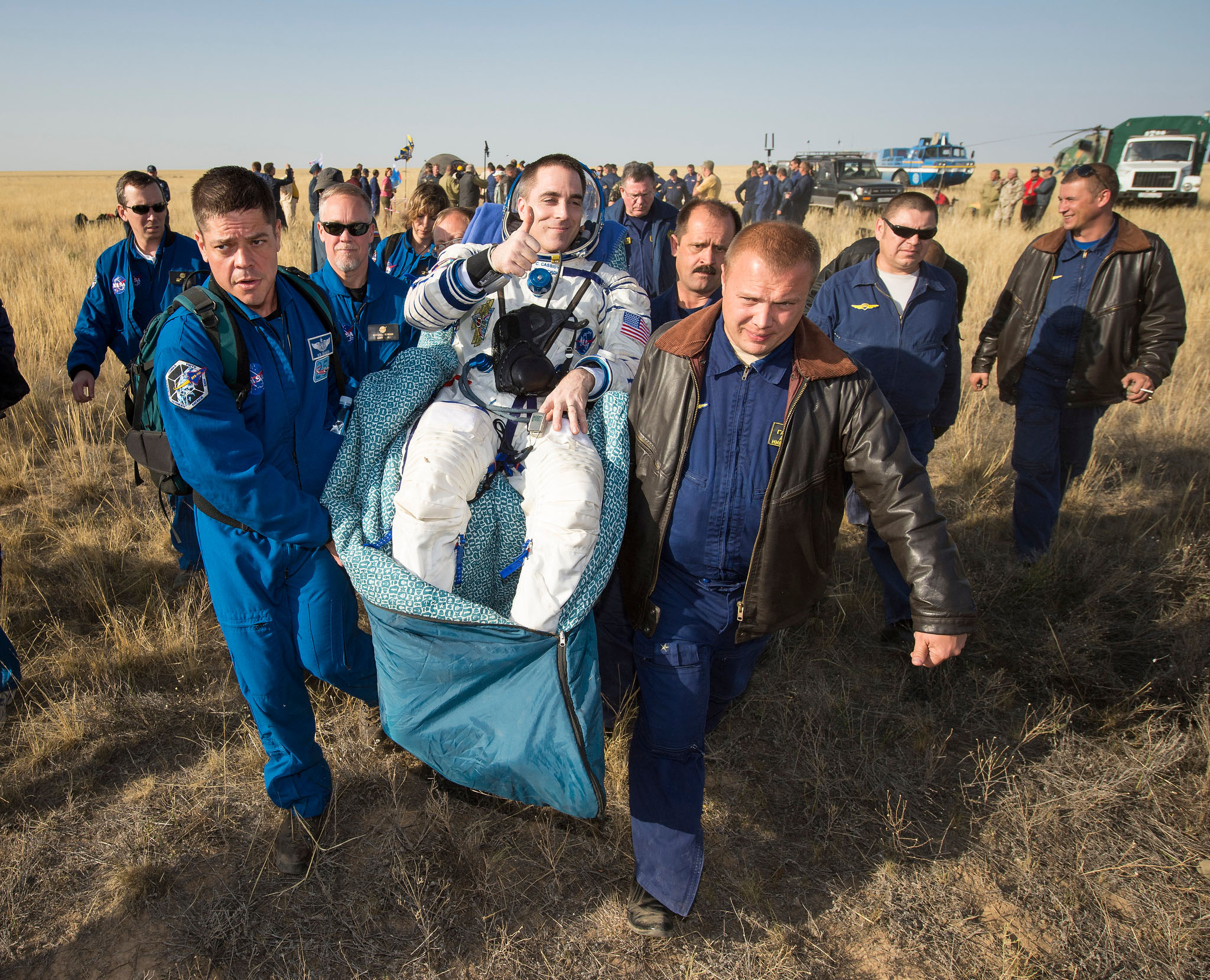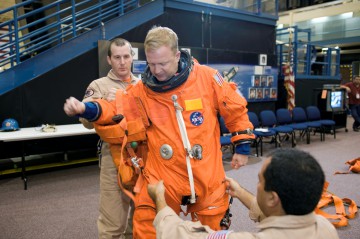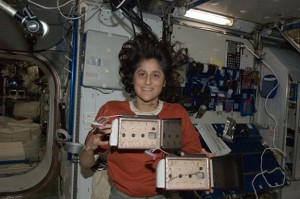
Less than two years since returning from his most recent mission, and after a year of managerial positions of increasing responsibility, space shuttle and International Space Station (ISS) veteran Chris Cassidy has been appointed Chief of the Astronaut Office. Selected by NASA as an astronaut candidate in May 2004, Cassidy performed three spacewalks during shuttle mission STS-127 in July 2009 and a further three spacewalks during Expedition 35/36 in March-September 2013. He succeeds the outgoing chief, veteran astronaut Bob Behnken, who has led the office since August 2012. The departure of Behnken and his previous deputy, Eric Boe, both in a matter of just a handful of months, has long raised the interesting possibility that they may be contenders for positions aboard the opening flights of Boeing’s CST-100 and SpaceX’s Dragon V-2 piloted vehicles, both of which are expected to occur in the early-to-mid-2017 timeframe. This appeared to be confirmed yesterday (Thursday), when NASA announced the names of Behnken and Boe, together with fellow astronauts Sunita Williams and Doug Hurley, to work alongside Boeing and SpaceX for the first Commercial Crew missions, due to occur no sooner than mid-2017. At the same time, three veteran shuttle and ISS flyers have moved from active flight status into non-flying management roles within the Astronaut Office.
The highly respected Cassidy—a U.S. Navy Captain and former SEAL, one of the world’s Top 50 most experienced spacewalkers, and veteran of almost 182 days in orbit, across two missions—has seen a meteoric rise within the Astronaut Office since his return to Earth aboard Soyuz TMA-08M, alongside Russian cosmonauts Pavel Vinogradov and Aleksandr Misurkin, back in September 2013. In the months after the completion of his second space mission, Cassidy underwent a standard protocol of post-flight rehabilitation, lasting about six months, before he was appointed Chief of the Extravehicular Activity (EVA) and Robotics Branch in 2014. A well-placed source told AmericaSpace that EVA/Robotics is “a major branch of the office, right up there with Exploration and ISS Ops.” By March 2015, Cassidy’s official NASA biography noted his promotion to Deputy Chief of the 43-strong Astronaut Corps, replacing Boe. A previous AmericaSpace article explored the possibility that Boe may be one of several candidates for one of the inaugural Commercial Crew flights by Boeing’s CST-100 or SpaceX’s Dragon V-2 vehicles.

With Air Force Col. Behnken now having handed the chief’s mantle over to Cassidy, it came as little surprise to see his name appear on the roster of selected astronauts for the first Commercial Crew missions. Although he flew two short-duration shuttle missions to the ISS—STS-123 in March 2008 to deliver the first elements of Japan’s Kibo facility and STS-130 in February 2010 to install and activate the Tranquility node and multi-windowed cupola—Behnken was also involved in long-duration training in his earlier career. “He was in the pool for an ISS mission (ISS-15/16/17), but went back to shuttle,” the source told AmericaSpace, adding that he “wouldn’t be surprised to see him as Commander of a Dragon- or CST-launched crew of four.”
Yesterday (Thursday), NASA announced the names of Behnken, Boe, Williams, and Hurley to train for the first Commercial Crew missions from 2017 onward. All four are highly experienced, with eight previous missions and a tremendous amount of high-level managerial responsibility within the Astronaut Office between them. Air Force Col. Boe previously served as Pilot on STS-126 in November 2008 and STS-133—the final voyage of Shuttle Discovery—in the spring of 2011, and has served as Deputy Chief of the office and Director of Operations at the Star City cosmonauts’ training center, outside Moscow. Navy Capt. Williams, who also served a tenure as Deputy Chief of the Astronaut Office between her first and second missions, previously flew aboard Expedition 14/15 from December 2006-June 2007 and aboard Expedition 32/33 from July-November 2012. On the first of these missions, Williams secured a new record of 195 days for the longest single flight ever undertaken by a woman, which was recently broken by Italy’s Samantha Cristoforetti. She has also accrued more than 50 hours of experience during seven career EVAs, which makes her the world’s most seasoned female spacewalker. Additionally, Williams is the second most experienced female spacefarer of all time, with a cumulative 322 days in orbit. Finally, retired Marine Corps Col. Hurley also served a tenure as NASA’s Director of Operations in Star City and was until recently the Assistant Director of New Programs within the Flight Crew Operations Directorate (FCOD) at the Johnson Space Center (JSC) in Houston, Texas. He previously flew as Pilot on STS-127 in July 2009 and on STS-135, the final voyage of the shuttle fleet, in July 2011.

NASA lauded yesterday’s selections as “the latest major milestone in the Obama Administration’s plan to partner with U.S. industry to transport astronauts to space, create good-paying American jobs and end the nation’s sole reliance on Russia for space travel.” However, in the aftermath of SpaceX’s recent loss of a Falcon 9 v1.1 booster—which will eventually deliver the Dragon V-2 into orbit—it remains unclear whether the Hawthorne, Calif.-based company’s plan to stage an unpiloted test flight as soon as the fall of 2016 is achievable. Both SpaceX and Boeing are expecting to launch their first 14-day crewed missions, which will include Behnken, Boe, Williams, and Hurley, by mid-2017, a target shadowed with additional doubt as NASA struggles to secure full Congressional funding for the Commercial Crew Program.
That said, the selection of the first dedicated Commercial Crew cadre is significant, as the United States pushes ahead with its plans to return Americans to space, aboard a U.S. spacecraft, launched from U.S. soil. “I am pleased to announce four American space pioneers have been selected to be the first astronauts to train to fly to space on commercial crew vehicles, all part of our ambitious plan to return space launches to U.S. soil, create good-paying American jobs and advance our goal of sending humans farther into the solar system than ever before,” said NASA Administrator Charles Bolden. “These distinguished, veteran astronauts are blazing a new trail — a trail that will one day land them in the history books and Americans on the surface of Mars.”
“Today, NASA announced that it has selected four veteran astronauts to be the first to fly to space on commercial carriers,” said John Holdren, assistant to the President for Science and Technology and director of the White House Office of Science and Technology Policy. “Their selection allows NASA to move forward with the training necessary to deliver on President Obama’s ambitious plan for returning the launch of U.S. astronauts to U.S. soil, while creating good-paying American jobs, and moving us closer to the President’s goal of sending astronauts to Mars in the 2030s.”

Back in January, in Building 9 at the Johnson Space Center (JSC) in Houston, Texas, Boeing and SpaceX senior executives shed some light on the crew composition of the initial CST-100 and Dragon V-2 test flights. According to John Elbon, Boeing’s Vice President and General Manager of Space Exploration, it appears likely that an in-house test pilot will accompany a NASA astronaut on the first CST-100 mission. At the opposite extreme, SpaceX President Gwynne Shotwell explained earlier this year that she does not anticipate flying any in-house SpaceX test pilots aboard any of the Dragon V-2 missions and that all will be crewed exclusively by NASA personnel. At the same press conference, JSC Director Dr. Ellen Ochoa announced that an initial cadre of astronauts would be named in the first instance, to better understand the training requirements, and from that pool the first CST-100 and Dragon V-2 crews would be selected. In other words, she did not expect individuals to be announced in the first instance—as was the modus operandi throughout the shuttle era—but instead selected from within the cadre.
With Behnken’s departure, the Astronaut Office now has its 15th Chief in 53 years. Ever since the appointment of Deke Slayton as “Co-ordinator of Astronaut Activities” in September 1962, and the subsequent selection of America’s first man in space, Al Shepard, as the first Chief, numerous veteran astronauts have held the mantle. Shepard remained chief from November 1963 until July 1969, when he stepped down to begin training as Commander of the Apollo 14 lunar landing mission, then resumed the position from June 1971 through his retirement from NASA in August 1974. Whilst Shepard trained for his mission, veteran astronaut Tom Stafford served as chief. Upon Shepard’s departure from the space agency, four-time spacefarer John Young became chief and served through April 1987, becoming the longest-tenured head of the Astronaut Office in history. Subsequent chiefs were Dan Brandenstein until 1992, Robert “Hoot” Gibson through 1994, Bob Cabana through 1997, Ken Cockrell through 1998, Charlie Precourt through 2002, Kent Rominger through 2006, Steve Lindsey through 2009, Peggy Whitson through 2012, and Bob Behnken until the recent appointment of Cassidy. Only three chiefs have previously served in the mantle of deputy before their elevation: Cassidy, Whitson, and Rominger.
As Deputy Chief, Cassidy carried program oversight responsibility for what one space analyst and historian described as “all the big ones, from Capcoms to EVA to Exploration to ISS Ops.” This repositioning of the astronaut personnel within the office’s management structure was timely, in view of planning for NASA, Boeing and SpaceX to assign a “pool” of candidates to the opening salvo of CST-100 and Dragon V-2 test flights. It remains to be seen if the Behnken/Boe/Hurley/Williams quartet will train as a prime-backup/prime-backup capacity for the respective CST-100 and Dragon V-2 inaugural missions or if only a subset of the group will actually fly.
However, it has long been recognized that today’s Astronaut Office is quite different to the organization of the Apollo and early shuttle eras, when veterans such as Al Shepard, John Young, and Dan Brandenstein enjoyed lengthy tenures of between 5-13 years at the helm. In the late shuttle and post-shuttle eras, however, chiefs have typically rotated into and out of the post after about three years. “Long-stay chiefs ended with Brandenstein,” the source told AmericaSpace.
At the same time, three other veteran ISS astronauts—Catherine “Cady” Coleman, Rick Mastracchio, and Steve Swanson—have reportedly moved off active flight status and into Astronaut Office management positions. The trio boast a total of ten space missions, a cumulative 603 days in orbit, and a total of 14 EVAs, lasting a combined 81 hours. Across their respective careers, Coleman, Mastracchio, and Swanson have traced the development of the ISS from its earliest incarnation, flying precursor Spacelab missions, assembling and maintaining the multi-national outpost throughout its first 15 years of operational life, and each occupying the space station for several months apiece as expedition crew members.
The appointment of Cassidy to replace U.S. Air Force Col. Behnken was made by NASA’s Director of Flight Operations, Brian Kelly, who described the outgoing chief as having “provided outstanding leadership of our astronaut corps during the last three years.” Mr. Kelly stressed that Behnken’s “selfless dedication and sound guidance has been top-notch as NASA ramped up research aboard the International Space Station and began laying the groundwork for human exploration missions beyond Earth orbit.” Offering a nod to the incoming chief, Mr. Kelly highlighted the Navy’s has “a long history” supporting NASA. “Frogmen helped astronauts return from a splashdown at sea,” he said. “Now, we are proud to have a frogman leading the Astronaut Office. Chris has served this nation admirably in the most challenging of circumstances and he will be a great leader for the Astronaut Corps.”
Want to keep up-to-date with all things space? Be sure to “Like” AmericaSpace on Facebook and follow us on Twitter: @AmericaSpace




5 Comments
5 Pings & Trackbacks
Pingback:All-Civilian Soyuz TMA-17M Crew Ready for Wednesday Launch to Space Station (Part 1) « AmericaSpace
Pingback:CST-100 Spacecraft Development Moves Forward in Former Shuttle Hangar « AmericaSpace
Pingback:Frustrated Bolden Urges Congress to Fund Commercial Crew, Announces $490 Million Contract Modification With Russia « AmericaSpace
Pingback:‘A Proud Legacy’: Remembering Atlantis on 30th Anniversary of Maiden Flight (Part 1) « AmericaSpace
Pingback:First Hundred, Next Hundred: ULA Celebrates Centenary, Readies For Challenges Ahead « AmericaSpace